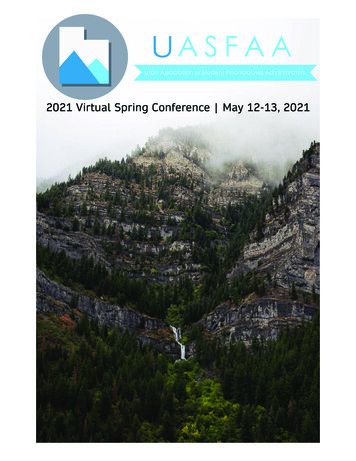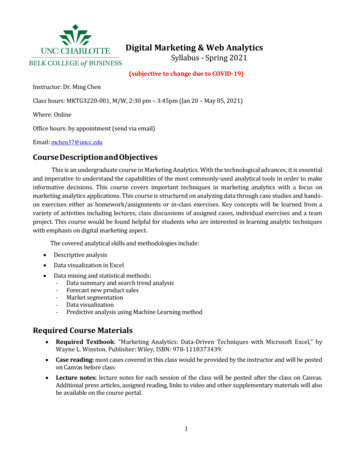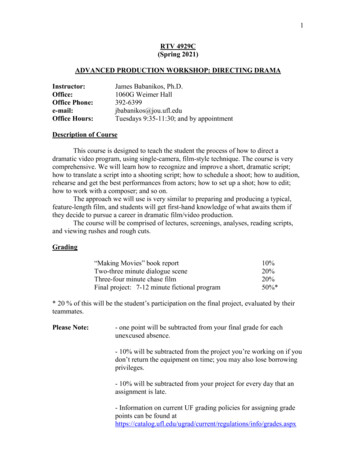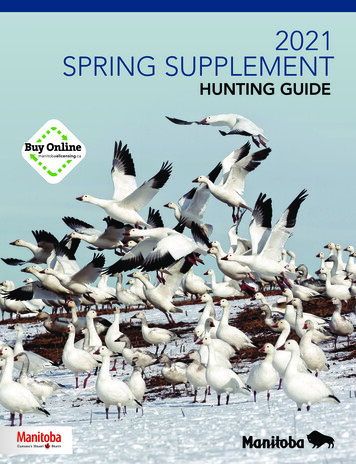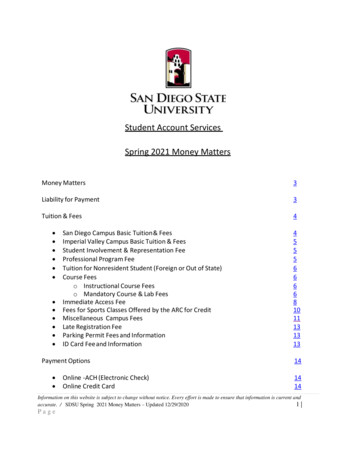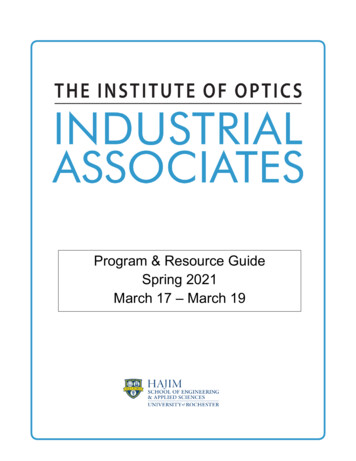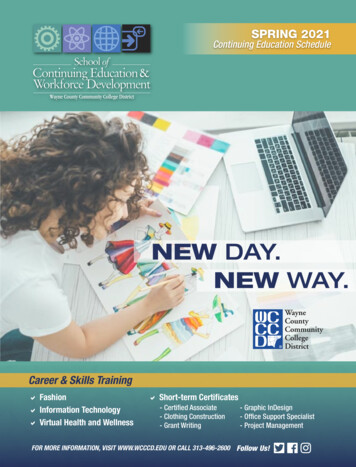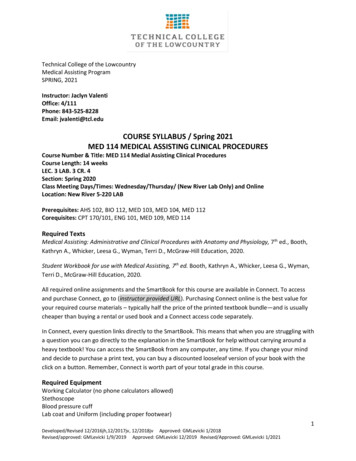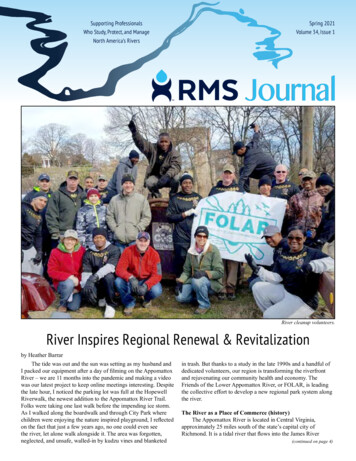
Transcription
Supporting ProfessionalsWho Study, Protect, and ManageNorth America’s RiversSpring 2021Volume 34, Issue 1JournalRiver cleanup volunteers.River Inspires Regional Renewal & Revitalizationby Heather BarrarThe tide was out and the sun was setting as my husband andI packed our equipment after a day of filming on the AppomattoxRiver – we are 11 months into the pandemic and making a videowas our latest project to keep online meetings interesting. Despitethe late hour, I noticed the parking lot was full at the HopewellRiverwalk, the newest addition to the Appomattox River Trail.Folks were taking one last walk before the impending ice storm.As I walked along the boardwalk and through City Park wherechildren were enjoying the nature inspired playground, I reflectedon the fact that just a few years ago, no one could even seethe river, let alone walk alongside it. The area was forgotten,neglected, and unsafe, walled-in by kudzu vines and blanketedin trash. But thanks to a study in the late 1990s and a handful ofdedicated volunteers, our region is transforming the riverfrontand rejuvenating our community health and economy. TheFriends of the Lower Appomattox River, or FOLAR, is leadingthe collective effort to develop a new regional park system alongthe river.The River as a Place of Commerce (history)The Appomattox River is located in Central Virginia,approximately 25 miles south of the state’s capital city ofRichmond. It is a tidal river that flows into the James River(continued on page 4)
RMS President’s CornerExecutive Director’s EddyMain OfficeRisa Shimoda, Executive DirectorPO Box 5750, Takoma Park, MD 20913-5750(301) 585-4677 / cell (301) r Training CenterRiver Studies and Leadership CertificateAngie Fuhrmann, Coordinator(480) 818-3649 / angie@river-management.orgNational Rivers ProjectJames Major, Coordinator(540) 717-3595 / james@river-management.orgCommunicationsBekah Price, Coordinator(423) 943-2000 / bekah@river-management.orgProfessional PurchaseRick Waldrup, Lead(406) 925-1554 / riverguy@bresnan.netAnja Wadman, Assistant(801) 388-2214 / awadman@blm.govDarin Martens, Swamper(307) 413-9913 / darin.martens@usda.govRMS Store / MerchandiseJudy Culver(928) 443-8070 / jculver@blm.govRMS JournalCaroline Kurz, Editor / Design(406) 549-0514 / caroline@river-management.orgNational OfficersJudy Culvert, President, Taos, NM(928) 443-8070 / jculver@blm.govShannon Bassista, Vice President, Boise, ID(208) 373-3845 / sbassista@blm.govHelen Clough, Secretary, Juneau, AK(907) 790-4189 / hcloughak@gmail.comRob White, Treasurer, Salida, CO(719) 221-8494 / rob.whiteco@gmail.comEmma Lord, Chapter Liaison, Loudon, NH(518) 728-4029 / emma lord@nps.govEx-Officio AdvisorsLinda Jalbert, Past President(928) 638-7909 / l jalbs@yahoo.comBob Randall, Kaplan, Kirsch & Rockwell LLP(303) 825-7000 / brandall@kaplankirsch.comNate Hunt, Kaplan Kirsch & Rockwell LLP(303) 825-7000 / nhunt@kaplankirsch.comSteve Chesterton, US Forest Service(202) 205-1398 / smchesterton@fs.fed.usEditorial PolicyArticles are not edited for content and may not reflect theposition, endorsement, or mission of RMS. The purposeof this policy is to encourage the free exchange of ideasconcerning river management issues in an open forumof communication among the RMS membership. Unlessindicated, points of view are solely those of the author.2After practicing COVID-19 pandemicresponse precautions for a year, a light atthe end of the tunnel beckons, cautiously.As we have learned and been remindedrepeatedly how resilient, resourceful,brilliantly bold and fabulously frail weeach are, we’ve witnessed creativity andpatience in ourselves and others to learnenthusiasm for flexibility and developingalternative plans.We have become proficient atattending, setting up, and recordingvirtual meetings with friends, family andcolleagues. It is no longer outlandish toparticipate in conferences, conduct multiday training workshops and interviewfor jobs via desktops and phones, just aswe’ve watched our children attend classesand take music lessons via the familylaptop. As a species, we are pretty darnresilient.Whether we work on the river eachday or study the critters that live there,we have become familiar with pandemicinspired levels of outdoor recreation.And, having survived unprecedentedlevels of visitorship on and around ourrivers, we have developed protocols towelcome visitors safely. More evidence ofresilience!As a result of the response to thesobering and undismissable voice forsocial justice, we have seen steps takento address inhospitable and inequitableworkplace environments and are thrilledto see bold, thoughtful change charted.Training workshops initiated throughthe A-DASH Collaborative, dedicatedto positive and supportive means to ridworkplaces of sexual harassment, havebegun. At the April 2021 Symposium,we will reboot conversations initiatedin 2020 by the River ManagementRoundtable (formerly the State RiverPrograms Working Group) to understanddiversity, equity, and inclusion tenets —and answer the question “What can I doto increase awareness, understanding,and change in myself, my organization,Crazy is how most of us would describe2020 in both our personal lives and in ourprofessional lives. We have sailed throughthe challenging times and are lookingforward to the moment we put our oarsand paddles in the water and rememberwhy each one of us seeks out the rivers,lakes, and oceans.and my community?” We will learn aboutone of the first-in-the-nation statewideworkplace systems whose processes havebeen evaluated with a diversity lens andreframed to create meaningful change.Speaking of the From MountainCreeks to Metro Canals OnlineRiver Management Symposium: thisRMS hallmark event offers as muchprogrammatic depth as ever. We will meetVirginia Governor Northam, RichmondMayor Stoney, and US Senator MarkWarner; hear from over 50 presenters;meet sponsors and attend field trips about,along, and at the James River. Since manySymposium organizers have been at it forover two and a half years, we salute you!Thank you Co-Chairs Dr. JamesVonesh and Lynn Crump, Program ChairHelen Clough, Marketing Chair EmmaLord and team members Joni Gore,Kelleen Lanigan, Allyson Conner, LucyPortman, Katie Willi, Angie Fuhrmann,Bekah Price, James Major, and Dan Carrfor your enthusiasm, patience and capacityto pivot, big time!uI thank you all for trusting that I cancarry forward with RMS’s mission inthe shadow of Linda Jalbert, whomwe all know to have been a great RMSPresident. RMS was successful underLinda’s leadership and the Board ofDirectors made great leaps and boundsto move RMS into the new centurywith huge accomplishments, including:the conversion of the 2020 symposiumand the River Ranger Rendezvous intovirtual programs for 2021, launching theRiver Training Center, and continuing toimprove and add three new schools to theRiver Studies and Leadership Certificateprogram.The Spring RMS Journal is coming outas river managers rub their crystal balls,magic mirrors, or just toss a coin in thewater in an attempt to determine what theriver season will look like and in hopesthat the roll-over river permits from 2020are launched successfully.Ironically, the last six months have proventhat the River Management Societycommunity has expanded beyond rivermanagement — we came together withoutfitters to discuss how to operate safelyin the COVID world, and how othersare dealing with user conflicts due toincreased use of public lands. The RMSlistserve has been utilized even morefrequently to locate information regardingissues such as multi-language signage,recreation site development, sceniceasements, interpreting the new executiveorder for masks, and addressing memorialsthat are popping up around the country.Although our relationships in the past yearhave been experienced mostly throughwavering screens — “can you hear me?”moments and frustrations with technology— the fact that we are missing personalinteractions, away from computers ortelephones, only increases the value of therelationships we have built or are buildingthrough RMS. We continue to recruit thenext generation into river management— to help fill the gaps of those who haveretired or are retiring in the near future —and it is important for RMS to continuethis work in the coming years.May the new generation, as well asthose of us who have been part of thiscommunity for many years, continue tostrive to explore new avenues and ideas toimprove river management for everyonewho wishes to experience the wonders ofthe water.u— the fact that weare missing personalinteractions, awayfrom computers ortelephones, onlyincreases the valueof the relationshipswe have built or arebuilding through RMS.Judy CulverRMS PresidentRisa ShimodaExecutive DirectorJournalSpring 20213
(FOLAR, from page 1)and ultimately the Chesapeake Bay. The section of river in theFOLAR service area is referred to as the “lower” AppomattoxRiver, a 20-mile stretch from the Brasfield Dam at Lake Chesdinto the confluence with the James River. It flows through threecities of Colonial Heights, Hopewell and Petersburg and threecounties of Chesterfield, Dinwiddie and Prince George andthe area is referred to as the Tri-Cities Region.The landscape is as varied as the river, passingthrough both rural forested landscapes and urbancity centers.Historically settled by Native Americans atthe falls of the Appomattox River, this regioncontinued to thrive in the Colonial period throughthe Industrial era as the river was the hub of alleconomic activity including manufacturing andtransportation. In fact, this region boasted one ofthe largest ports in the state in the 1700s and one of the largestcities in the 1800s. Factories and mills lined the riverbanks,powered by the mighty flow of the river, and a canal systemextended the navigation inland to western cities. Following themills and factories, many towns and villages were also locatedalong the banks of the river. Recreation and amusement parkswere located on the river at sites like Flea Island and FerndalePark. Like many communities, the addition of the railroadchanged the look and feel of the community, but the regionmaintained its economic standing into the late 1800’s and mid1900’s. Slowly, as the economy shifted away from the river,we were left with a communityphysically disconnected from theriverfront. Canals and railroadsmade the riverfront inaccessibleand forgotten. As small-towneconomies were impacted by bigmalls and suburban sprawl of the1980s, the community continuedto decline. Today we are seeing areinvestment back into our smalltowns as historic factory buildings become apartments, coffeeshops and breweries. Our region, with its historic architecture,is a popular backdrop for movie and television productionincluding a wide variety of genres ranging from Lincoln to TheWalking Dead. The first fully state supported African Americancollege, Virginia State University, is located on the banks of theAppomattox River, along with the first freed black communitylocated on Pocahontas Island. Our rich history, coupled with adedicated community and a scenic river, make this region’s futurebright.mouth of the James River. While the scenic river designation inthe 1970s set the stage for riverfront renewal, it wasn’t until thelate 1990s that efforts really got underway.Collective Impact and CollaborationOur work at FOLAR stems from a regional river study of the1990s. Instead of sitting on ashelf, the community formed anonprofit to take on the workof the study. Our missionis to conserve and protectthe Appomattox River inpartnership with the communityfor all to enjoy. And we areaccomplishing that missionby building the AppomattoxRiver Trail, a 25-mile greenway and blueway through the region,something we heard was important to the community througha strategic visioning process. We completed the regional trailmaster plan in 2017 and are consistently working towardsimplementing that plan mile by mile.The nonprofit was volunteer based for many years, but inthe last five years we have added two professional full-time staffand are looking to add one more staff member this year. We can’tsay enough about the groundwork that was laid by our foundingboard members. They had the vision, and just as importantlythey had the passion and grit, to put in the on-the-ground worknecessary to build support and partnerships incity council chambers, business meeting rooms,and with many diverse stakeholders — to makethe vision of revitalized riverfront a reality. Mostimportantly, they were local and had a widenetwork of friends and family that they broughtto the vision and the organization.At FOLAR, we believe the AppomattoxRiver Trail has the capacity to positively impactmany aspects of our community. This projectis about land conservation, protecting scenic views, and thewater quality of a regional drinking water supply. This projectis about community wellness by increasing public access togreenspace along the riverfront for paddling, walking, fishing,and picnicking. This project is about transportation, providing analternative form of transportation in a region that has low rates ofcar ownership. This project is about stewardship, education, andcommunity pride as the river becomes an outdoor classroom. Thisproject is about economic development, providing opportunitiesfor entrepreneurs and community amenities that corporationsseek in a region.That is why FOLAR works so hard to build cross-sectorrelationships and has organized around the concept of collectiveimpact to the region. Collective impact is an intentional wayof working together and sharing information to solve complexissues, with a backbone organization coordinating the effort.FOLAR serves as the regional backbone organization for thedevelopment of the Appomattox River Trail. And because of thatrole, we have a large and diverse network that has us servingon health-focused work groups, partnering with Chambers ofCommerce and collaborating with the local university. TheAppomattox River Trail has statewide significance as well aslocal appeal. It is featured in the Governor’s Conserve VirginiaFOLAR’s mission is to conserveand protect the AppomattoxRiver in partnership with thecommunity for all to enjoy.‘Collective impact’ brings peopletogether in a structured way,map and is listed as a featured project in the region by theVirginia Outdoors Plan while also appearing in all the localcomprehensive plans. Funding to support FOLAR and its missioncomes from a wide variety of partners including conservationorganizations, local business and industry, and health legacyfoundations.Making ProgressEvery community along the Appomattox River is increasingtrail and river access and working together to create a regionalsystem. While our goal is to have 25 miles of continuous trail,including several dedicated bicycle and pedestrian bridges, wehave about 10 miles of trail on the ground today. The master planvision is for the trail route to be safe and accessible for all agesand abilities and will be an accessible and paved shared-use pathwhere possible, though a portion of our trail route will be onroad with bike lanes and sidewalks. We are excited to be part ofconstructing 3.5 miles of bike lanes along our route this year. Wealso just completed a Blueway Plan, thanks to a local graduatestudent. This plan will help guide the future infrastructureneeded to improve the paddling experience alongside the traildevelopment.Back at the Hopewell Riverwalk, we truly have experiencedthe “if you build it, they will come” phenomenon. The Riverwalkhas won two awards in its first year — including the Governor’sEnvironmental Excellence Award as a Gold Medal winner — andsees thousands of visitors each month. Not bad for a park thatsaw a few visitors a day prior to the Riverwalk. And downtownHopewell is feeling the benefits of a new nearby recreationalamenity. The Hopewell Downtown Partnership, an accreditedMain Street program, was formed in 2007 and assisted in therevitalization of downtown. Today there are increased housingoptions and local coffee shops, bakeries, restaurants, and a theaterall within walking distance of the Riverwalk, truly making thisarea a destination. And the Riverwalk will double its length tobe a total of 3,140’ by the end of 2021 and will link downtownto another asset, the Hopewell City Marina. The marina not onlyoffers a launch for paddling and motorboats but serves as a publicgreen with summer concerts and events. The Riverwalk will offera safe way to connect parts of town that are currently difficult tonavigate on foot. This new connectivity will certainly increasevisitation among locals and tourists alike.Through the years we have seen that it is people workingtogether, in pursuit of a common goal and with respect for ournatural environment, that is making our scenic rivers and thepublic spaces along them a place for all people to enjoy andbenefit from now and for generations to come.uIf you want to learn more about the Appomattox River,join the Regional Renewal & Riverfront sessionat the RMS Symposium on April 14, 2021, at 2:30pm (EST).Heather Barrar is the Regional Trails Program Director forFOLAR. Heather is trained as a forester and arborist buthas spent most of her career as a suburban planner makingconnections across all sectors to address community concernsand improve the quality of life for all. She is excited to work in aregional role to address active transportation, land conservation,economic development, environmental stewardship, and climatechange by building the Appomattox River Trail.to achieve social change.(collectiveimpactforum.org)The River as a Recreational Asset (recent history)By the 1970s, the community saw the potential of theAppomattox River as a recreational asset. The community knewthat the lower Appomattox River offered an experience likeno other through unparalleled natural beauty and the relaxedconvenience of nearby small-town hospitality. The river offers allsorts of experiences, including both whitewater and tidal flatwaterfor paddlers, unspoiled riverbanks for fishing and birding, andthe experience of an explorer while walking and discovering thehistoric remains of the early industrial era. The original scenicriver designation, a legislative action in Virginia, was approvedin the 1970s and was extended twice in the 2000s to reach the4JournalHopewell Riverwalk. Photo: Daniel JonesSpring 20215
The author paddling by one of many Soak Creek cliffs.Protecting Natural Treasures —Big and Small, Near and Far, Now and Foreverby George LindemannThis year, the New River Gorge Park and Preserve becamethe 63rd national park. The designation had bipartisan support.The National Park Service has managed the river since 1978when President Carter designated it a national river. While thenew national park designation won’t materially change thecurrent management, the federal park status has already raised thegorge’s profile.I am a middle-aged paddling enthusiast with a home inEastern Tennessee. I have always thought about heading northto West Virginia but haven’t yet done it. After reading countlessnational stories about the recent designation, I am determined topaddle the New River this spring. And I will bring my wallet withme. The Outdoor Industry Association estimates that 9 billionper year is spent on outdoor activities in West Virginia. Andstudies show that the national park designation could boost NewRiver trips by as much as 20 percent. Count my family and meamong them!Like most designations, the newest national park did nothave unanimous support. Anglers and backcountry huntersobjected to the loss of hunting lands, yet compromise was6eventually reached. After years of negotiations, 10 percent of thegorge was named a national park, and the remaining 90 percentremained a national preserve and river, where looser regulationsallow for more activities. Designations of any kind d
college, Virginia State University, is located on the banks of the Appomattox River, along with the first freed black community located on Pocahontas Island. Our rich history, coupled with a dedicated community and a scenic
